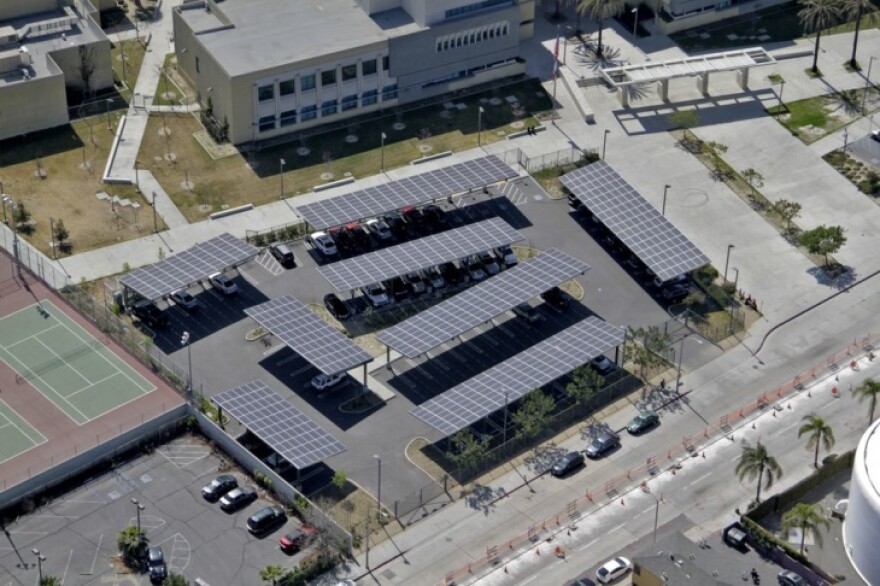Truth matters. Community matters. Your support makes both possible. LAist is one of the few places where news remains independent and free from political and corporate influence. Stand up for truth and for LAist. Make your year-end tax-deductible gift now.
LAUSD's Own 'Green New Deal' Calls For Ditching Non-Renewable Energy By 2040

Imagine getting rid of every school bus, heating system, boiler, oven or stove in the Los Angeles Unified School District that currently runs on fossil fuels, and replacing them with an alternative powered by "clean, renewable" energy.
"It's a heavy lift," said LAUSD chief facilities executive Mark Hovatter. "It's a very heavy lift."
Still, L.A. Unified School Board members are considering exactly that. On Tuesday, they'll consider adopting an aggressive set of goals that would ultimately wean the nation's second-largest school district off of all non-renewable energy sources by 2040.
And that's only the long-term goal. The legislation the board's considering would also commit LAUSD to relying exclusively on clean sources of electricity by an even earlier deadline: 2030.
You might call it LAUSD's own "Green New Deal."
"The school district is an enormous energy user," said LAUSD board member Jackie Goldberg, "so if we can get out of fossil fuels -- first for our classrooms and schools, and then for our transportation vehicles and trucks -- we will be making a significant reduction in the carbon footprint of our massive district."
LAUSD is also the L.A. Department of Water and Power's single-largest customer -- which means, advocates say, any progress the school district makes would go a long way toward the City of L.A.'s overarching climate goals, which call for relying only on renewable energy sources by 2045.
"This is a huge deal -- history-making for Los Angeles," said Sybil Azur, a parent of an LAUSD student and co-leader of the 100% Green Schools L.A. coalition, a primary supporter of the school board's action.
CAN IT BE DONE?
Maybe? If the district is to meet some of its 2040 goals, even advocates admit that existing technology will have to improve. For example, electric school buses can travel somewhat longer distances now, but remain prohibitively expensive.
The total price tag for the transition could also be enormous -- $3 billion, Hovatter estimated -- if LAUSD attempted to pay for it alone.
But advocates say the district would have ready partners willing to help cover some of the costs of switching to renewable energy sources, particularly in the electric sector.
A 'COST-NEUTRAL' SWITCH TO SOLAR?
For instance, solar power developers -- concerned that current transmission lines won't be able to carry energy from all the panels they've placed in the Mojave Desert -- are desperate for roof space in urban Southern California.
LAUSD has more than 60 million square feet of roof space, said Michael Zelniker, also a leader of the 100% Green Schools L.A. coalition. Under programs known as "Feed-in Tariff," solar power companies would pay LAUSD to use that space.

"There's no cost at all to the district," Zelniker said, "because they don't own the system. They don't maintain the system. All the district is doing is providing the space for the solar installation."
Zelniker said LAUSD could draw from the power of these solar installations. The solar companies would sell the excess -- and pay LAUSD a dividend.
"There should be a way that it's not only cost-neutral, but actually brings in revenue," said Goldberg at a Nov. 14 committee hearing.
SO WHAT'S STOPPING THEM?
Even with solar, the devil will be in the details. In the past, installing solar panels has meant drilling holes in some very old roofs.
"We have a gym where we installed solar eight years ago," Hovatter recalled. "We ripped it off because we just renovated the gym, and the roof leaks because we [had] solar."
Alternative methods exist for installing solar panels on school building roofs -- they involve straps that anchor the panels with no hole-drilling required -- but Hovatter said LAUSD is still awaiting state regulatory approval before using them.
Hovatter noted similar state regulations restrict LAUSD's ability to install wind turbines on its campuses.
Regulators, he explained, are "ultra-conservative when it comes to childrens' safety."
WHAT'S NEXT?
If the board approves the resolution, the first order of business will be to convene a task force of district staff, renewable energy experts and representatives of local utilities, to help develop an implementation plan.
The resolution calls for convening the task force by January 2020. The implementation plan would be due back to the school board by January 2021.







